www.soldiersandsailors.us
Home│2009
Trip to France│Other
WWII Veterans I Know│The
WWII Memorial│The
Home Front│Contact
Me
WWII Events Page with Photos│Latest
Happenings│6th
Beach Battalion│Who
am I?
The Sergeant
John W. Gabersek Jr. Memorial Scholarship
2007 D-Day Conneaut Re-enactment Story
When we were young.
Reflection’s
by Eric Montgomery
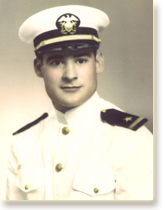 Two years ago I was
amazed that I had the opportunity to speak with not only my great
uncles commanding officer, but as it turn out, his trusted friend,
Ensign Joseph Vaghi, Beachmaster, Easy Red Sector, Omaha Beach.
Since last fall’s reenactment I had the privilege to meet him in
person. In fact, little did I know at the time that less than 6
months later I would meet many of the men who knew my great uncle and
were under Ensign Vaghi’s command at their annual, and perhaps last,
unit reunion.
Two years ago I was
amazed that I had the opportunity to speak with not only my great
uncles commanding officer, but as it turn out, his trusted friend,
Ensign Joseph Vaghi, Beachmaster, Easy Red Sector, Omaha Beach.
Since last fall’s reenactment I had the privilege to meet him in
person. In fact, little did I know at the time that less than 6
months later I would meet many of the men who knew my great uncle and
were under Ensign Vaghi’s command at their annual, and perhaps last,
unit reunion.
On the 63rd anniversary of the Normandy invasion, ten proud
sailors from all over the country met near Bedford, Virginia, site of
the National D-Day Memorial, for 3 days over the course of the first
week of June. To me this was a once in a lifetime opportunity to
meet the men who served, trained and took part in what some would argue
to be the pivotal moment of the 20th century, D-Day, June 6th,
1944.
Many of the soldiers training for the invasion as well as the
surrounding townspeople of Salcombe England were quite confused over
the sight of these men. Who were they these sailors dressed as
soldiers, donning bloused trousers under tall paratrooper’s boots, who
carried rifles, carbines and tommy guns, and wore helmets painted in
strange colors? Were they commandos? Were they members of
an elite Navy combat team of airborne frogmen? Or were they
just young men assigned with one of the most important tasks on
D-Day? The answer would definitively come on that morning
of that Day of Days - the United States Navy Beach
Battalion’s.
For nearly 50 years the sacrifices made by these Navy men under Army command was
widely ignored so much so that the men of the Naval Beach Battalions coined the
phrase “Son’s of Beaches” indicating the scope of their abandonment. It
wasn’t until June 14th 2000 that the unit finally received the recognition that
they deserved when they were finally issued a Presidential Unit Citation.
Yet who were these men, who came ashore during the initial and second waves of
the assault, who prepared the beach to receive more than 20000 tons of daily
cargo, who cared for the wounded, provided boat repair services, established
communications and then slipped quietly into history?
Aside from meeting Beachmaster Vaghi again along with his son Joe, I
would have the honor of meeting Pharmacist Mate Andy Chmiel and Vince
Kordack, Signalman Richard “Red” Onines, Motor Machinist Mates John
Rogers and Clyde Whirty, Radioman Torre Tobiassen, Hospital Apprentice
Frank Walden, and Seamen Curtis Fleming and Bob Giguere. With
their wives in tow as well as the proud family of Lt. Commander Emmit
Hall and the son of platoon C-8 Doctor Russell Davey, Ken Davey and
family, I indeed was in the presence of forgotten heroes. My
cousin Jim Ameen also joined me getting to know these men who
emphatically declare that “we are not heroes, those who never returned
are”.
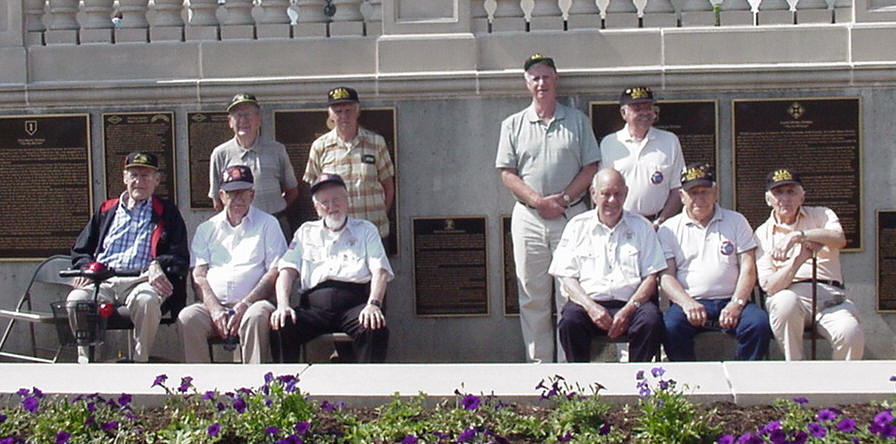
Unfortunately due to an unexpected illness, my great uncle’s friend
Coxswain Ed Marriott could not attend. I’ve spoken to Ed on a
number of occasions and looked forward to meeting him for the first
time. Yet those who were there did more than answer my questions
regarding my great uncle, they inspired me to learn all I can, to
explain what happened there on those blood stained beaches to
generations of Americans to come. For that is why we are here
today in Conneaut, to remember those lost, to relive the struggle and
to celebrate the lives of the men who returned.
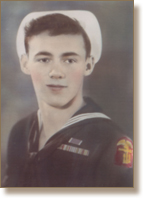 The first man I met at the reunion was Seaman 1st
Class Bob Giguere. Bob and I had spoken a number of times on the
phone prior to conversing at length about his D-Day experiences.
I ran across his video taped interview purely by accident on a web site
called witness-to-war.org. Until then, I did not know that Bob
would be one of the last men to see my great uncle alive. Seconds
from that chance meeting on the beach with Amin, he too was taken down
by the very same explosion. Knocked down but not out.
The first man I met at the reunion was Seaman 1st
Class Bob Giguere. Bob and I had spoken a number of times on the
phone prior to conversing at length about his D-Day experiences.
I ran across his video taped interview purely by accident on a web site
called witness-to-war.org. Until then, I did not know that Bob
would be one of the last men to see my great uncle alive. Seconds
from that chance meeting on the beach with Amin, he too was taken down
by the very same explosion. Knocked down but not out.
Moments before, Giguere was still aboard his ship, a LCIL or Landing
Craft Infantry (Large). Hitting a mine as it approached the
shoreline; the #85 was taking on water and lodged itself on a
sandbar. First of the larger ships in, she presented herself as a
huge target to the German coastal gun batteries. Shortly after
jumping off the end of the starboard side ramp, Giguere was hit by
shrapnel from an exploding artillery round which hit the ship.
The explosion blew off the ramp Bob just leapt from and killed many of
the men following behind. As a result Bob earned his first Purple
Heart of the day. (The ship sank later that morning after
striking another mine.)
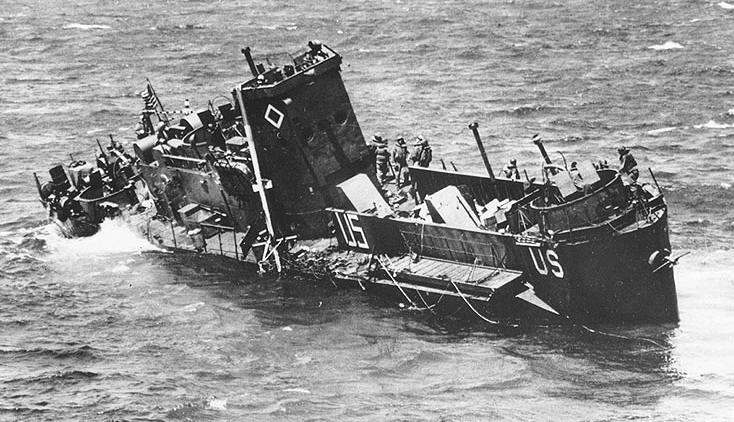
The explosion on the beach which killed my great uncle would not deter
the survivors as the Germans had planned. It would serve to
inspire them. Just then 17 year old Giguere stepped into the
history books. Although the jobs of the Beach Battalion men were
limited to the beach itself, drastic times call for drastic
measures. Seaman Giguere was to find himself at the forefront of
an Army led assault on a series of bunkers. Bravely facing fire
and slipping underneath barbed wire he along with his Army buddies
moved up the beach onto a series of German pillboxes. Giguere
played catch with a number of grenades which were being tossed to him
over an anti-tank ditch. He and another man destroyed the
emplacements one by one. For that, he was to be awarded the
Silver Star, the only Navy man on D-Day to be so honored. After
moving inland he secured the safe passage of some newly liberated
French citizens to the relative safety of the beach. At that
moment, a second blast from a mortar shell was to retire Giguere from
the fighting in France and earn him his second Purple Heart for the
day. He would awaken in England 4 days later on his 18th
birthday. Ironically, he returned to the states via the Queen
Mary, the same ship which brought him and his battalion to
England. After his recovery, Bob was later to be wounded
for a third time taking a bullet in the leg during the invasion of
Okinawa, Japan.
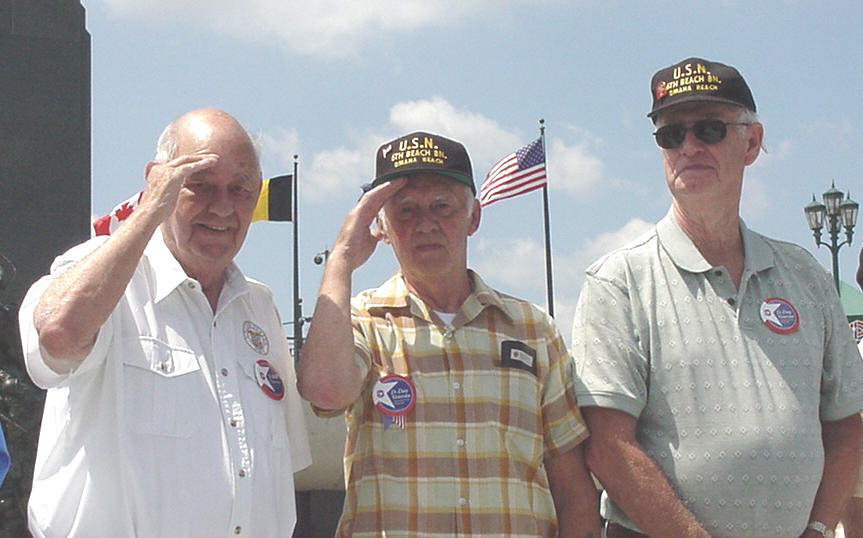 Clyde
Whirty, a tall an imposing figure, was also 17 years old on
D-Day only older than Giguere by 3 days. His task on the morning
of the invasion was to clear paths on the beach for the incoming troops
by using a large bulldozer. Yes, a bulldozer. He came
ashore on a LCM as part of the first wave. The ship is about the
same size as the transports being used today here in Conneaut.
Trouble is, no one checked to see if the imposing dozer would fit on a
LCM until they tried the morning before the invasion. As a
frantic search for a torch to remove a foot off of each side of the
dozers blade ensued, Clyde ran into two very important dignitaries; the
King and Queen of England. The royal couple was there to inspire
the men and to pass out American flags as a show of support to the
troops. Clyde was to receive one of these flags directly from
Queen Elizabeth whom Hitler declared to be “the most dangerous woman in
Europe.” Despite the warning from Herr Hitler, Clyde took the
flag and proudly secured the Stars and Stripes to his dozer. Upon
landing, the Germans didn’t take too kindly to the flag and zeroed in
on Clyde and his dozer knocking it out and nearly the driver.
Wounded, yet undaunted, Clyde commandeered another dozer, affixed Ole
Glory again and went on about his duties. All the while the
Germans continued to fire at dozer number 2 along with Clyde at the
helm. They eventually found the beast’s weak point and knocked
that one out as well. I was to learn at the reunion that it was
Ensign Vaghi who ordered Whirty to stow that flag as he climbed aboard
dozer #3 telling him that the flag was the focus of the fire directed
at him. Despite orders, Clyde and our flag carried on drawing
deadly fire away from hundreds of his brother in arms. Clyde
still owns that very same flag, blood stained and bullet riddled, which
is undoubtedly being the first American flag to be on the beach.
Although his actions were never awarded with a commendation, the
actions of this one man, determined to get the job done, embodies the
spirit of every member of the Beach Battalion. Why he was never
recognized for this obvious act of selfless courage escapes logic.
Clyde
Whirty, a tall an imposing figure, was also 17 years old on
D-Day only older than Giguere by 3 days. His task on the morning
of the invasion was to clear paths on the beach for the incoming troops
by using a large bulldozer. Yes, a bulldozer. He came
ashore on a LCM as part of the first wave. The ship is about the
same size as the transports being used today here in Conneaut.
Trouble is, no one checked to see if the imposing dozer would fit on a
LCM until they tried the morning before the invasion. As a
frantic search for a torch to remove a foot off of each side of the
dozers blade ensued, Clyde ran into two very important dignitaries; the
King and Queen of England. The royal couple was there to inspire
the men and to pass out American flags as a show of support to the
troops. Clyde was to receive one of these flags directly from
Queen Elizabeth whom Hitler declared to be “the most dangerous woman in
Europe.” Despite the warning from Herr Hitler, Clyde took the
flag and proudly secured the Stars and Stripes to his dozer. Upon
landing, the Germans didn’t take too kindly to the flag and zeroed in
on Clyde and his dozer knocking it out and nearly the driver.
Wounded, yet undaunted, Clyde commandeered another dozer, affixed Ole
Glory again and went on about his duties. All the while the
Germans continued to fire at dozer number 2 along with Clyde at the
helm. They eventually found the beast’s weak point and knocked
that one out as well. I was to learn at the reunion that it was
Ensign Vaghi who ordered Whirty to stow that flag as he climbed aboard
dozer #3 telling him that the flag was the focus of the fire directed
at him. Despite orders, Clyde and our flag carried on drawing
deadly fire away from hundreds of his brother in arms. Clyde
still owns that very same flag, blood stained and bullet riddled, which
is undoubtedly being the first American flag to be on the beach.
Although his actions were never awarded with a commendation, the
actions of this one man, determined to get the job done, embodies the
spirit of every member of the Beach Battalion. Why he was never
recognized for this obvious act of selfless courage escapes logic.
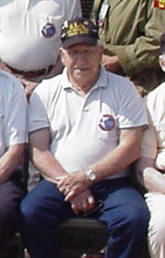 Frank Walden’s story is intertwined with the
youngest of all the Beach Battalion sailors; Virgil Mounts. At 16
years of age, Hospital Apprentice Mounts of Kentucky, along with fellow
Hospital Apprentice Frank Walden found cover along a stretch of the
sand. The 88’s soon found them. Since I was not there, I
will take a passage from “Red” Onines personal written memories to
convey the story as it happened and as he saw it unfold. In
“Red’s” words, “When the two stretcher
bearers who had laid down in front of us were hit, Mounts & Walden
were the two Navy medics who got up from the relative safety of the dip
where we were lying. They both jumped up from the little bit of
protection we had and went to help the wounded GI and the two GI
stretcher bearers who were carrying him. While they were trying to
treat these three wounded GI’s, the next group of shells landed and
killed Mounts as he was kneeling about three
feet in front of me with his left side toward me. I actually
saw the shrapnel fragments go through his body front to back and saw
him screaming even though I couldn’t hear him. He was screaming and
spewing his insides out and died instantly. The shrapnel passed through
him and struck Walden who was kneeling facing us. Walden was hit in the
left side, arm, and leg. He and Walden should have gotten a
medal.”
Frank Walden’s story is intertwined with the
youngest of all the Beach Battalion sailors; Virgil Mounts. At 16
years of age, Hospital Apprentice Mounts of Kentucky, along with fellow
Hospital Apprentice Frank Walden found cover along a stretch of the
sand. The 88’s soon found them. Since I was not there, I
will take a passage from “Red” Onines personal written memories to
convey the story as it happened and as he saw it unfold. In
“Red’s” words, “When the two stretcher
bearers who had laid down in front of us were hit, Mounts & Walden
were the two Navy medics who got up from the relative safety of the dip
where we were lying. They both jumped up from the little bit of
protection we had and went to help the wounded GI and the two GI
stretcher bearers who were carrying him. While they were trying to
treat these three wounded GI’s, the next group of shells landed and
killed Mounts as he was kneeling about three
feet in front of me with his left side toward me. I actually
saw the shrapnel fragments go through his body front to back and saw
him screaming even though I couldn’t hear him. He was screaming and
spewing his insides out and died instantly. The shrapnel passed through
him and struck Walden who was kneeling facing us. Walden was hit in the
left side, arm, and leg. He and Walden should have gotten a
medal.”
Frank Walden’s life was saved unknowingly by Virgil having taken the
direct blow of the exploding shell. Some of those shrapnel pieces
passed through Virgil’s body ending up in Frank’s. Frank would
then be carried off the beach by “Red” Onines who had lost his hearing
in the same explosion. Frank would take 6 months to
recover. Hospital Apprentice Don Burrows, who also was injured in
the blast, finally heard how he made it off the beach that day.
At a reunion held 45 years later, Frank and wife Barbara took their
seats opposite “Red” and wife Virginia on a chartered bus. Don
Burrows, sitting in the seat in front of Onine’s along with his
granddaughter, turned to Frank and said, “You know Frank, I wish I knew
how I made it off the beach that morning. Frank replied, “That’s
simple, turn around, it was Red Onines that carried you.” (If
only to be a fly on the wall at that moment.)
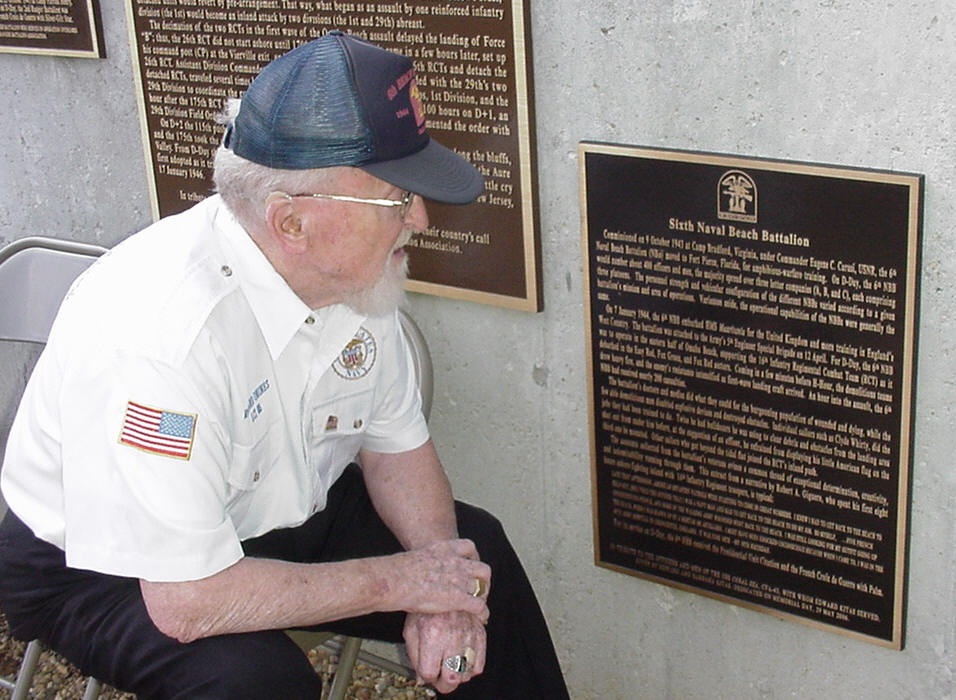
Unfortunately space and time limits me from sharing all the story’s
told to me over those 3 days, yet over the coming years, I will
continue to share the bravery and dedication to duty that these men
still exhibit today. To witness these 10 men standing tall so
proudly, receiving both applause and tears from hundreds of supporters
at the D-Day Memorial is a sight I will never forget. Capping off
this extraordinary experience was a film presented by Joe Vaghi’s son
which he acquired from a source in France. The film showed never
before seen footage taken from the mast of my great uncle’s ship, the
LCI-L #88, and footage of the LCI-L 85 as it sank in the channel.
You could have heard a pin drop in the room as we all watched in great
amazement over this newly discovered footage. At that moment, I
wondered what these veterans may be thinking. What immediately
came to my mind was...
“When we were young, when we were young”…

Click the tent to go back to front page.
 Two years ago I was
amazed that I had the opportunity to speak with not only my great
uncles commanding officer, but as it turn out, his trusted friend,
Ensign Joseph Vaghi, Beachmaster, Easy Red Sector, Omaha Beach.
Since last fall’s reenactment I had the privilege to meet him in
person. In fact, little did I know at the time that less than 6
months later I would meet many of the men who knew my great uncle and
were under Ensign Vaghi’s command at their annual, and perhaps last,
unit reunion.
Two years ago I was
amazed that I had the opportunity to speak with not only my great
uncles commanding officer, but as it turn out, his trusted friend,
Ensign Joseph Vaghi, Beachmaster, Easy Red Sector, Omaha Beach.
Since last fall’s reenactment I had the privilege to meet him in
person. In fact, little did I know at the time that less than 6
months later I would meet many of the men who knew my great uncle and
were under Ensign Vaghi’s command at their annual, and perhaps last,
unit reunion. The first man I met at the reunion was Seaman 1st
Class Bob Giguere. Bob and I had spoken a number of times on the
phone prior to conversing at length about his D-Day experiences.
I ran across his video taped interview purely by accident on a web site
called witness-to-war.org. Until then, I did not know that Bob
would be one of the last men to see my great uncle alive. Seconds
from that chance meeting on the beach with Amin, he too was taken down
by the very same explosion. Knocked down but not out.
The first man I met at the reunion was Seaman 1st
Class Bob Giguere. Bob and I had spoken a number of times on the
phone prior to conversing at length about his D-Day experiences.
I ran across his video taped interview purely by accident on a web site
called witness-to-war.org. Until then, I did not know that Bob
would be one of the last men to see my great uncle alive. Seconds
from that chance meeting on the beach with Amin, he too was taken down
by the very same explosion. Knocked down but not out.
